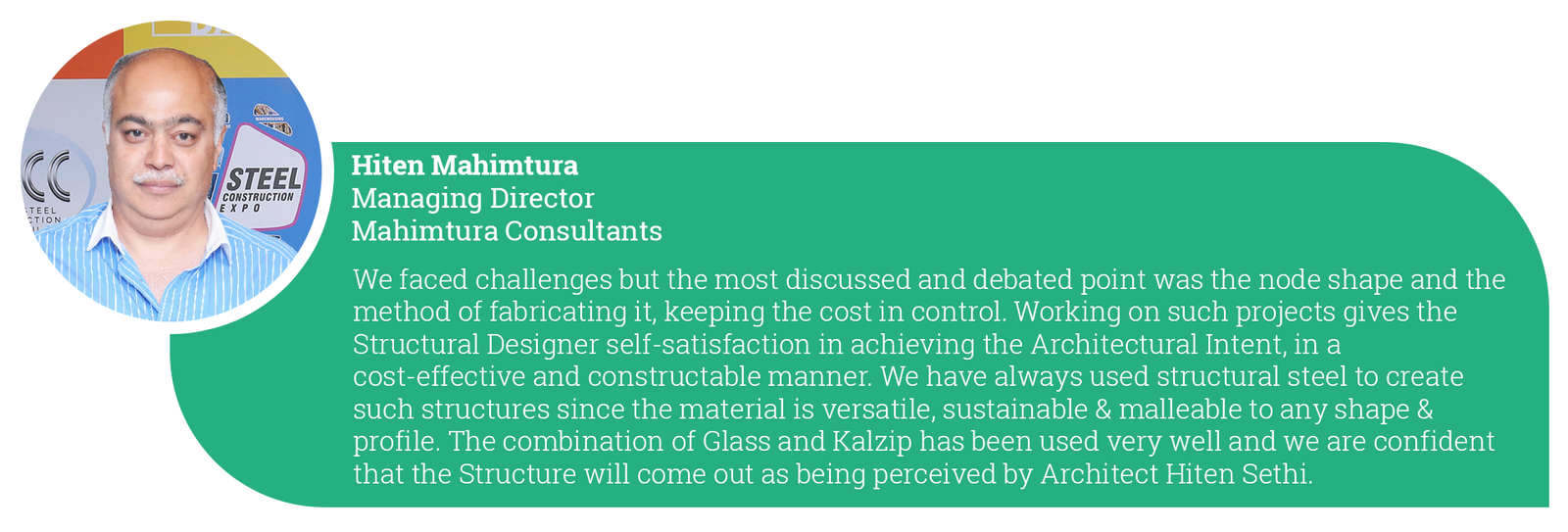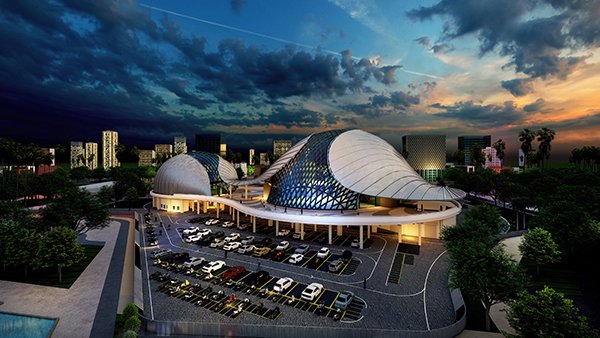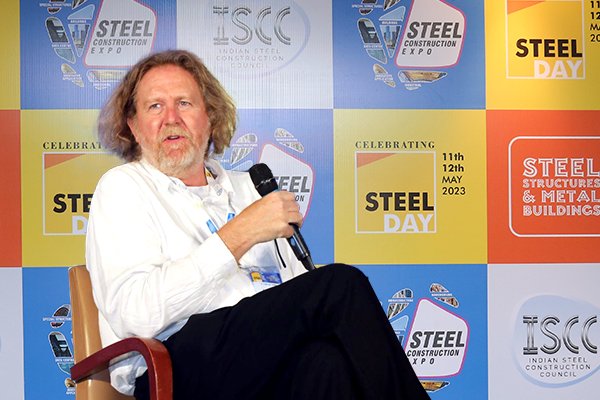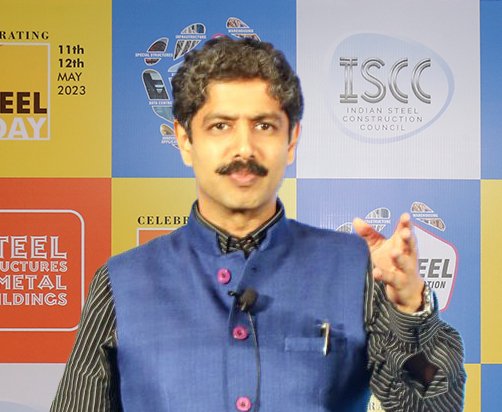Project Brief
Navi Mumbai Municipal Corporation (NMMC) has been at the forefront of people-centric development, continuously striving to enhance the livability standards of its residents. The total buildup area of the project is approximately approx. 2,00,000 sq. ft. The project configuration has two wings, namely, the Museum Building with Gr. Floor + 3 Floors + Roof and the Convention Centre with Gr. Floor + Mezzanine Floor + 2 Floors + Roof.
Embracing this vision at Hiten Sethi & Associates (HSA), a renowned architectural firm based in Navi Mumbai, has played a pivotal role in envisioning, designing, and executing numerous landmark public infrastructure projects for NMMC. Among these achievements is the development of the Science Centre, an iconic structure within the widely acclaimed Wonders Park. As the architects behind this futuristic project, HSA took inspiration from the potential of science and technology to shape our future, creating a captivating and sustainable venue that encourages exploration, scientific experimentation, and critical thinking.


Vision
From its inception, the Science Park was envisioned as a global icon, showcasing sustainable attractions that would inspire and captivate young minds with the wonders of science and technology. To bring this vision to life, our design team embarked on a thought-provoking journey, contemplating the profound impact of science on our future. This led to the conceptualization of a futuristic architectural form, where steel emerged as a natural choice due to its versatility, strength, and aesthetic appeal.
Choice of Material
One of the most striking features of the Science Park is the integration of two parametric dome structures, harmoniously blending with the surrounding urban context. These domes boast a diagrid steel structural system, which serves as the backbone of the entire project. The choice of steel was driven by its ability to create large column-free spaces, allowing for unobstructed views and seamless enclosure. With a floor height of 6 meters, the exhibition zone is a testament to the immense possibilities offered by steel’s remarkable strength-to-weight ratio.
Design Details
At the core of the Science Park’s design philosophy lies an emphasis on interactive spaces that foster learning and exploration. With strategic circulation movements facilitated by indoor ramps and escalators, visitors can seamlessly navigate the floor plates, engaging with exhibits that correspond to various themes. The design’s functionality, sustainability, energy efficiency, and safety considerations create an environment that sparks curiosity and encourages the exploration of science’s ethical, social, moral, and economic implications.

Façade:
The Science Park’s façade serves as a captivating visual representation of its essence. Embracing a combination of standing seam aluminum sheet insulated roofing skin and a diagrid glazing system, the structure exudes elegance and futuristic charm. This cladding material not only enhances the visual appeal but also ensures optimal lighting conditions within the exhibition areas. In addition, translucent elements allow natural light to filter in, creating an immersive and inviting atmosphere for visitors.
Geometry
Geometry plays a crucial role in the design and construction of the Science Park, particularly in its innovative diagrid system. This remarkable structural feature begins from the first-floor ring beams, providing strength and stability to the entire building. The diagrid members are connected to the ring beam through rigid connections, ensuring a robust and reliable framework. The average aperture opening measures 2.2 meters by 2.2 meters, allowing ample natural light and ventilation to permeate the interior spaces.

Structural Details
Substructure & Superstructure in Brief:
The structure has in situ Pile foundations and a combination of 600 mm and 750 mm diameter piles of length up to 18 m
Pedestrian ramp is a special feature from the ground to 1st floor level
Structural steel canopy on 1st floor
Unbonded PT beams are considered at the 1st, 2nd and 3rd floor of the science center building.
Science Centre & Convention Centre dome will be connected by truss members and purlins by providing a few stub columns starting from the diagrid members
The internal height of the dome varies from 3 mts. to 11 mts at various sections
Total Structural Steel Quantity (MT) is 450 to 500 MT (approx.)
3rd party testing agency has been appointed for all structural steel material supply and execution of quality assurance
Fire protection intumescent paint is proposed for structural steel members as per NBC as well as local CFO requirement
Grade of reinforcement – Fe500
Concrete grade – M 40, M 35 and M 30
Total Structural Steel Quantity of this system is approximately 450 to 500 MT

Façade:
In order to enhance the aesthetic appeal of the facade, purlins have been strategically placed to support the glass or kalzip material, adhering to the detailed specifications of the façade design. Another notable architectural element is the pedestrian ramp, specially incorporated to provide easy access from the ground level to the first floor. This ramp not only serves a functional purpose but also adds a touch of uniqueness to the design.
Canopy:
On the first floor, a structural steel canopy adds an element of grandeur to the overall composition. Additionally, unbounded post-tensioned (PT) beams are utilized on the first, second and third floors of the science center building, enhancing structural integrity and minimizing deflection. These beams provide an efficient solution, enabling longer spans and reducing the need for additional support columns.

Dome:
The dome within the Science Centre and Convention Centre exhibits varying internal heights, ranging from 3 meters to an impressive 11 meters. This exceptional architectural feature showcases the ingenuity and versatility of the design. Sincere Park stands as a testament to the harmonious blend of structural excellence and aesthetic beauty, setting new benchmarks in architectural innovation. There are 2 unique diagrid sizes for two different domes i.e., 85 m x 65 m span and 50 m x 40 m span. The average aperture opening size is of 2.2 m by 2.2 m. E 250 and E 310 structural steel grades have been used to build the domes.
Quality & Testing:
The integration between the Science Centre and Convention Centre has been achieved through truss members and purlins, with stub columns attached to the diagrid members. To ensure the highest standards of quality, a third-party testing agency has been appointed to oversee the selection of all structural steel materials and execute quality assurance measures. Furthermore, in compliance with the National Building Code (NBC) and local Chief Fire Officer (CFO) requirements, fire protection is provided through the application of intumescent paint on the structural steel members.
Challenges
Since the entire project is unconventional in shape and form, the main challenges were in tackling the actual execution of the work and planning of shuttering and manpower involved for the successful execution of the work. Temporary staging shall be provided for all assemblies and shall be maintained till all members of the diagrid system were connected at both ends. Its design needs to be cross-checked from a stability perspective and re-shoring also needs to be taken into account to ensure accuracy and safety, during erection. The sequence of shuttering and de-stagging is very important in such types of structures so that the load transfer takes place efficiently and effectively. The structural design of the main domes was complex and as a result, the concept of a diagrid structural system was used as the main structural supporting system of the project.
Software Used
The Science Park’s design and detailing process relied on a synergy of cutting-edge software tools. The team utilized Autocad, Rhino, Revit and Tekla to create a comprehensive digital framework for the project. These software platforms enabled the architects to visualize, analyze, and refine the design, ensuring accuracy and efficiency throughout the project’s lifecycle.
In Conclusion
The Science Park stands tall as a symbol of the limitless possibilities offered by the convergence of architecture and steel. Its captivating design, futuristic aesthetic, and commitment to sustainability make it a true masterpiece. The architects are immensely proud to have contributed to this iconic project, which showcases the immense potential of steel in crafting extraordinary structures that inspire, educate, and push the boundaries of human imagination. With its impending completion in early 2024, the Science Park promises to become a beacon of knowledge, awe, and inspiration for generations to come.






